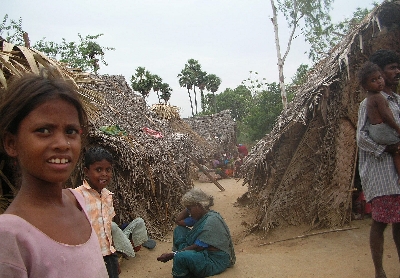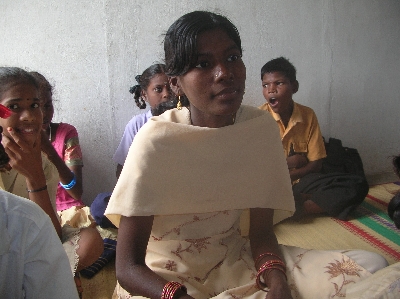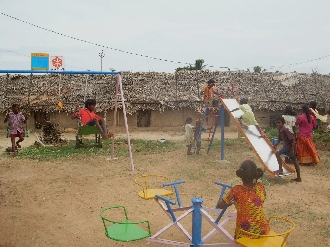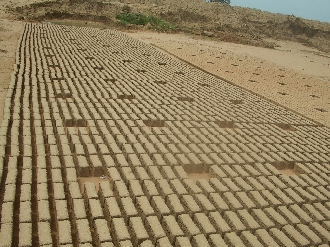Kancheepuram/Thiruvallur: Mariamma (12) and her neighbour and classmate Selvi (12) have been asked to stay away for a week from their school the Kunnavakkam Primary School at Uthiramerur block in Kancheepuram dt (60 km south of Chennai) of Tamilnadu. The informal suspension is not a result of a misdemeanour or indiscipline but because of extensive skin disease and upper respiratory infection that they have repeatedly fallen prey to.
Our class teacher told us that we are falling ill too often and could spread it to others. She asked us to get medical treatment before returning to school," says Mariamma.

![]() Selvi she does not know her age, nor has any records. She has been asked to come to school after successfully treating her upper respiratory infection. On a break from school to get well, Selvi gets no break from sibling care at the Irula resettlement at Kunnavakkam village. Pic: Krithika Ramalingam.
Selvi she does not know her age, nor has any records. She has been asked to come to school after successfully treating her upper respiratory infection. On a break from school to get well, Selvi gets no break from sibling care at the Irula resettlement at Kunnavakkam village. Pic: Krithika Ramalingam.
But Mariamma, her classmate, their parents and twenty other families were only recently rescued from bonded work in a stone quarry near their village and were resettled into temporary structures at the Irula (scheduled tribe) colony in the village. And the colony, like scores of those excluded from villages, has neither basic facilities like water or toilets nor access to medical services.
Activists from Social Action Movement, the NGO that built the temporary structures while the Irulas await government compensation, had taken Mariamma and Selvi to the government-run Primary Health Centre in a nearby village and had them attended to. It was past the one week mark when I met Mariamma and Selvi in their homes. Both were responding well to the treatment for their infectious diseases, but were broken in spirits.
Mariamma says her class teacher had been discriminating against them for a while, putting them down since the school opened. After the breakout of the skin infection, she asked the students to take time off school. Neither Mariamma nor Selvi is sure she wants to return to school. After all, in their colony, every single kid had it. SAM called in themal. The nurses at the PHC had applied tincture of iodine and sent the kids back.
Dropping out and early marriage
For the activists of SAM, this is a double blow. We had a tough time establishing the age of the children without birth certificates and admitting them in an appropriate class. We convinced the school to admit the 12-year-olds in Class III after putting them through a bridge course, because they had never been to school before. It took us a lot to motivate the Irulas into sending their girl children to school. And now this," says Raj (known by one name), a field worker with SAM.
The other dreaded fallout is girl child marriages that are common among Irulas. An adolescent girl who is not in school would in all likelihood be married off at menarche. By the time she is 16, she will be bearing children,'' says Raj.
SERIES
•
Zip through class V
•
Alternative education shackled
•
Malnutrition hits schooling -I
•
Malnutrition hits schooling -II
The only intervention that is available is a noon meal centre run by the NGO. Apart from a nutritious lunch no other services like weight measurement, nutritious balls or immunisations are provided here. The Commissioners appointed by the Supreme Court (in the PUCL vs Union of India Right to Food Act case) have mandated that mini anganwadis centres be opened at sites where bonded labour exists. But for the children living in stone quarries, brick kilns or rice kalams,the government services are only on paper," says Raj.
The Kunnavakkam families are only representative of an estimated 12,000 families, according to SAMs estimates, living in bondage working in stone quarries, brick kilns and mining sand, in the district. Many thousands are involved in silk weaving and live in bondage-like conditions in their own homes. Nearly 80 percent of the bonded labourers are from the Scheduled Castes and Tribes and mostly from the families of agricultural labourers, says a report submitted by the Supreme Court Commissioners Dr N C Saxena and Harsh Mander to the apex court in August 2008. http://www.righttofoodindia.org/data/comm2008eighthreport.doc.
Their food security status is so fragile that a single failed crop, drought, or heath emergency can disturb the delicate balance of surviving. Credit is not taken only for emergency situation but also for everyday life necessities. Most often, bondage is adopted as a coping mechanism from absolute hunger. Even the children surrendered to bondage indicate the extent of household food insecurity, the report concludes.
It has been well established that bondage occurs because the poorest of the poor are uncovered by government food and livelihood schemes. In Tamilnadu less than half of children below the age of 6, from the lowest socio-economic quintile receive any services from the anganwadis in the past year even though nearly all (98.3 per cent) have physical access to anganwadis. Like the Irula resettlement camp that was hardly a kilometre away from the village ICDS centre, but the Irula children were excluded from the Government-run ICDS.
The Government schemes are still not reaching them, leaving them prone to exploitative work,'' says Raj.
Therefore the demand for temporary ration cards, says Additional Secretary, Nirman Mazdoor Panchayat Sangh R Geetha. The Sangh is the TN-wing of the national organisation that goes by the same name. The migrant bonded population may have ration cards in their villages, but have to buy the Re 1/kg PDS rice in the open market for Rs.10. A compulsory registration at work sites would ensure that the government has an idea of how many children are out of school, how many need nutritional interventions and how many need healthcare services," she adds.
Agrarian crisis and its impact on children
In the other neighbouring district of Chennai, Thiruvallur, the situation is no different. Only the industries are. Rice kalams or small scale paddy processing units and brick kilns are the main employers of bonded labours and children in bonded labour. At Vadakkarai village in Sholavaram Taluk (17 km NW of Chennai) I met D Meena and her brother D Selvam.

![]() Meena joined her family to work in Rice Mills near Vadakkarai in Thiruvallur, after her family took an advance against wages. Her family are agricultural labourers, but with less and less work available back home, the family is getting deeper and deeper in debt and therefore debt bondage.
Pic: Krithika Ramalingam.
Meena joined her family to work in Rice Mills near Vadakkarai in Thiruvallur, after her family took an advance against wages. Her family are agricultural labourers, but with less and less work available back home, the family is getting deeper and deeper in debt and therefore debt bondage.
Pic: Krithika Ramalingam.
Meena says that she is from Tindivanam in Villupuram district, and that her family works as agricultural labourers for six months during the cropping season. The dry months are spent at the rice mills.
Agriculture in our area is rain-fed and we need to seek other sources of employment during the rest of the year. At the rice mills, the work peaks during the summer when the paddy is de-husked, parboiled, and spread under the sun to dry," she added.
Meena dropped out last year after gaining admission into Class 9. Her family joined her grandmother to work at Periyar Mill, after taking an advance of Rs.30,000. Work for the family starts at 2 am when the women start a fire with coconut husks, rice husks and wood to parboil the rice. The men in the family load the threshed paddy into huge vats of water and wait for the husk to rise to the surface. The women and children then load the rice into the huge cookers for the rice to be parboiled.
Once the cooking process is over, the entire family spreads out rice in the kalam's concrete floor, at around mid morning. The rice has to be constantly turned under the sun to ensure uniform drying. For her part of the work starting the fire and spreading rice Meena was paid Rs.10 per day, say representatives from Jeeva Jyothi, an NGO involved rehabilitating rice mill child labourers.
I ask her pointedly what work she did in the kalam, and she answers I only help my family. An answer I hear often repeated by the children of bonded labour at the quarries, kalams and brick kilns. An answer that takes them into sibling care, household chores, into doing odd jobs at the work site for which they are paid token sums and takes them away from schools and into working full-time long before they turn 14.

![]() Children enjoy a break from learning at the playground equipment donated to Jeeva Jyothi run Anganwadi and learning centre at a brick kiln in Gnyayiru. Pic: Krithika Ramalingam.
Children enjoy a break from learning at the playground equipment donated to Jeeva Jyothi run Anganwadi and learning centre at a brick kiln in Gnyayiru. Pic: Krithika Ramalingam.
Meena now attends the non-formal school run by Jeeva Jyothi near the rice mills and is getting trained in other income generating jobs. She has no intent of returning to school to complete Class X anytime in the near future. After my family's financial troubles get over, I will write it as a private candidate, she hopes.
Bonded and moved out of their homes
In Gnyayiru village, around 20 km from Vadakkarai on the banks of the rain-fed Kosathalai River, I visit three brick kilns where Jeeva Jyothi has set up bridge schools and is working to get admission of the students in nearby government-run schools.. Almost all of the kilns' workforce is made of migrant workers from Villupuram, Theni, Dindigul, Pudukottai, Sivagangai and Kancheepuram districts. Interestingly, most of the 50-odd children I spoke to in all three of the kilns are enrolled either in schools or in ICDS centres in their home town. So when they move to live and work in the brick kilns between the Tamil months of Thai and Aadi (July and January), they drop out of school.
Jeeva Jyothi Founder Susai Raj says, the government did pass an order to accommodate migrant children and admit them into schools whenever they present themselves. But the schools need to submit their roll sheets to the Social Welfare Department for the provision of noon-meal and eggs. When the migrant workers' children join school they neither get the benefit of noon meal schemes, nor are they able to bring food from home. Their parents return home in the morning after working the whole night and are not in a position to cook for their school going children. Lack of access to the services and classroom hunger makes learning a tough proposition, leading to high drop out rates, he says.
Community migration
In the brick kilns I visited in Thiruvallur, I met more children who have moved from Kancheepuram, Thiruvannamalai, Villupuram, Theni, Nagapattinam and Sivagangai. Most children know each other from their home towns and know of other families from their home towns in nearby brick kilns. Some are related and have brought their families to the work sites, indicating that poverty alleviation measures in their places have not quite worked. Ironically, these districts, in addition to Salem, Cuddalore, Thanjavur and Perambalur, were target districts under a World Bank-funded project for poverty alleviation among tribal communities in 2005. And yet little has changed in the last four years.

![]() Cutting thousands of bricks along with the family, the children help pay off the advance that the family takes before migrating to brick kilns. The bricks need to be cut from wet, stomped out earth early morning, taking the children away from schools. Pic: Krithika Ramalingam.
Cutting thousands of bricks along with the family, the children help pay off the advance that the family takes before migrating to brick kilns. The bricks need to be cut from wet, stomped out earth early morning, taking the children away from schools. Pic: Krithika Ramalingam.
T Kavitha and M Maheshwari are 18 and 15, respectively, and are cousins from Thalavaipuram near Madurai. Both say they have been working in kilns in the area for four years now and both dropped out after class V to work with their families, when their families took an advance of Rs.40,000 nearly 4 years ago and have been paying off the loan since.
So I ask them the obvious question: Haven't you paid off the loan yet? Neither Kavitha nor Maheshwari knows their debt status. They can count the thousands of bricks they cut from clay daily within minutes, ironically they have no idea of how much money is still owed," says Susai, Community Organiser for Jeeva Jyothi in the brick kiln industry (no relation to Susai Raj).
Efforts to impart basic reading, writing and arithmetic skills among adolescent girls in the work sites are not welcomed by all brick kiln owners. There is still no transparency about the advance given to the workers. So the kiln owners have a vested interest in keeping the children uneducated, lest they should ask for accounts," he added.
At various meetings with NGOs and officials, brick kiln owners skirt around the issue of debt bondage. When asked about the reforms the owners have undertaken in their kiln, two kiln owners in Gnyayiru talk only about how they provide uniforms, notebooks and books for schooling and nutritious food to the children of their employees.
Where schools do come up, with or without kiln owner support
It has been small steps for the NGOs that work with both the government and the kiln owners' association in creating awareness about educating children and providing them with nutritious meals. In Thiruvallur, NGOs have started establishing centralised kitchens with support from kiln owners to provide noon meals, some owners have started ICDS centres in their premises, and others have a physician visiting every week for general medical care. The International Labour Organisation has been working in the Maduranthagam block of Kancheepuram districts with the help of kiln owners to improve living conditions.
And others like the Team for Education and Action Trust go one step ahead and try to end the cyclical migration of the children along with the parents, at least in a small scale. The Little Flower Primary School in Reddipalayam village now is home to around 200 Dalit children, whose parents either work in brick kilns or are migrant domestic workers elsewhere. R S Arputham, the founding trustee of TEA Trust, says that with lax policing along the Palar River basin area, there has been a sudden increase in brick kilns, many of which are not registered with the Labour Department.
I could count eight kilns within a kilometre radius from the school premises. Arputham says more brick kilns were on their way with construction and bund strengthening works going on in two more properties.
When we surveyed the chambers, we found the children had no access to anganwadis and therefore nutritious food, no sanitary toilets, and were prone to skin diseases because they helped parents in pressing the clay with their feet. The fine dust from the sand also made them prone to respiratory infections. Many children had eye-sight problems with a lot of sun damage. On the other hand, they were being pushed into the cycle of poverty with no education," says Arputham of the status of children in the neighbourhood kilns.

![]() These students of Little Flower Middle School, Reddipalayam posehappily in front of a placard that list the firsts in the country. They themselves are first generation learners, whose parents are still under debt bondage to kiln owners. Pic: Krithika Ramalingam.
These students of Little Flower Middle School, Reddipalayam posehappily in front of a placard that list the firsts in the country. They themselves are first generation learners, whose parents are still under debt bondage to kiln owners. Pic: Krithika Ramalingam.
The eight year old school also provides noon meals to the day scholars, apart from balanced nutrition to the boarding students. It has been four years since we applied to the Tamilnadu Government Social Welfare Department for mid-day meal scheme. We are an NGO-run school providing free of cost education to Dalits and migrant workers' children. If the government were to subsidise our noon meals, we will be able to mainstream more children into formal schooling," he adds.
Efforts of NGOs are spotty, with a very few of them having either the wherewithal or the support to stem the migration. But activists believe there are enough number of working example for the government to scale up interventions. P Belinda, HoD, Social Work Department, Madras Christian College and a migrant worker researcher, says that data collection both at the national level and at the district levels have has been inadequate. It then becomes difficult for the government to plan rehabilitation programmes for vulnerable populations. The children are worse hit because they are not the vote banks for politicians.
While the districts of Kancheepuram and Thiruvallur continue to show the typical intra-state migrant/debt bondage patterns, newer forms of bonded work are emerging elsewhere in the state. Activists believe a huge chunk of construction workers in Tamilnadu, working on IT parks and township developments are from the Andhra Pradesh, Orissa, Bihar and Uttar Pradesh.
Construction work in Tamilnadu is getting organised and welfare measures are in place, even if not available to all. Realty developers, therefore, choose to source labour from areas where poverty is still grinding", says Geetha. In other parts of the state, the Sumangali scheme and the camp labour practices are on the rise with the migration of single adolescent girls/boys and young adults increasing. But with the government still struggling to stem drop outs from migration in the 6 to 14 age group, the older children are left to fend for themselves.























